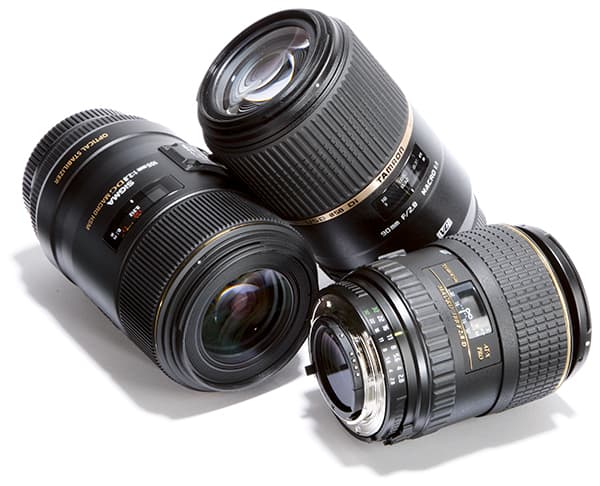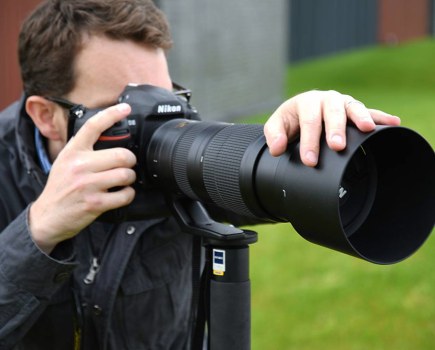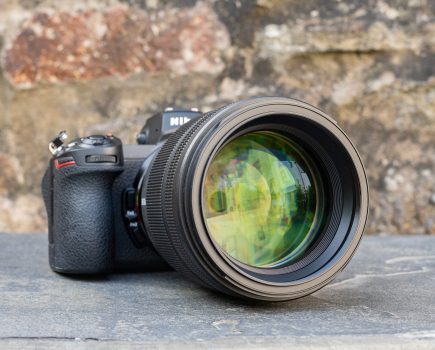Third-party macro lenses – Introduction
Focal lengths that sit in the 90-105mm range have always been the most popular for macro photography, and there have been some classic lenses that fall into this bracket. Many contemporary versions are based on the older designs, so there are a number of models from which to choose. Virtually every camera manufacturer offers a macro lens in the 90-105mm range, but for this review we will be comparing three third-party models: the Sigma 105mm f/2.8 EX DG OS HSM Macro; the Tamron SP 90mm f/2.8 Di Macro 1:1 VC USD; and the Tokina 100mm f/2.8 AT-X M100 AF Pro D Macro. Each is very highly regarded, with the Sigma lens recently winning AP’s coveted Fixed Focal Length Lens of the Year award for 2013. The Tokina 100mm lens is also very well respected, while the newest lens in the group, the Tamron 90mm, is the latest incarnation of a favourite lens that is around 30 years old.
With such an excellent range of lenses available, it can be tricky deciding which one is right for you. Although sharpness and detail resolution are, of course, critical, there are other factors to consider, such as how easy it is to manually focus the lens, how loud the AF motor is, and what the minimum working distance is. All these elements will have a bearing on how appropriate the lens is for macro photography. Of course, lenses of this length can also be put to other uses – portrait photography, for instance, and particularly head-and-shoulders shots.
Why 90-105mm?
Countless 90-105mm macro lenses have been produced over the years, and there is clearly a large market for them, but why are they so popular? In fact, there are a number of reasons why people like these lenses, and not all of them are related to macro photography.
First, the slight telephoto focal length allows the photographer to maintain a suitable working distance from their subject and still achieve a 1:1 magnification. In macro photography, it is vital to allow some space between the end of the lens and the subject, mainly because of the subject itself. Insects, for example, are likely to fly, or scuttle off, should the photographer get too close. The photographer must also avoid casting shadows over the subject – either their own or those of the camera and lens. When working up close to the subject, particularly in natural light, it can be difficult to illuminate the subject well, and it is all too easy to cast an obvious shadow across the scene.
All the lenses in this test have a minimum focus distance of around 30cm, which is significantly greater than the 18cm found on a 50mm macro lens. However, it is important to remember that the minimum focus distance is measured from the nearest point of focus to the focal plane, which is the surface of the film or sensor. Therefore, the flange depth and length of the lens must be deducted from the minimum focus distance to give a minimum working distance, which is the distance from the end of the lens to the subject. The longer the working distance, the easier it is for photographers to light the subject unobstructed and make sure the lens shadow doesn’t fall across the scene.
At around 100mm in focal length, a fixed lens should also show very little, if any, curvilinear distortion. Physically, a lens of this focal length should also be a good compromise between size and focal length. Longer focal lengths will need to be larger and heavier to include an f/2.8 aperture and, as a result, will be extremely difficult to use handheld for macro images.
For portrait images the focal length allows enough distance between the photographer and the subject to maintain a comfortable working space, both for lights and to make sure the subject doesn’t feel crowded. For documentary shots it also allows a photographer to work without the danger of inserting themselves into the scene.
Finally, at around £350-£500, the cost of the lens is quite reasonable. So, in short, excellent image quality is within the reach of most photographers in a lens that is surprisingly versatile, and which makes possible a number of other applications besides macro work. Therein lies their popularity.
What is most interesting, given the similar focal lengths, is that these lenses have quite different optical formulations. The Sigma 105mm lens has 16 elements in 11 groups and is arguably the most complex. Special low dispersion (SLD) glass is used to correct curvilinear distortion and chromatic aberration, while super multi-layer coating helps reduce flare and ghosting. We were extremely impressed with this lens when we tested it in AP 14 January 2012, in which it was awarded five stars – it was one of the sharpest we have tested.
Tamron’s 90mm lens has a completely new optical design, changed from that of its highly praised predecessor. Rather than the 10 elements in nine groups of the older model, this newest lens has 14 elements in 11 groups. The Tamron lens uses two extra low dispersion elements, with one low dispersion element, all of which help to reduce chromatic aberration and optical distortion. The new extended bandwidth and angular dependency coating (eBand), developed by Tamron, has an ultra-low refractive index that, when combined with multi-layer coatings, is claimed to reduce flare and ghosting and improve contrast.
Tokina’s 100mm lens is the oldest design in this review, as it was originally released in 2006. It also has the simplest optical design, with nine elements in eight groups. The lens replaced the older Tokina 100mm f/2.8 AT-X M100 AF optic, which was originally designed for film use. As a result, the current lens has multi-coatings to cope with the higher reflectivity of a digital sensor, which can cause ghosting and flare.
One feature added to the newer Sigma and Tamron lenses is optical stabilisation, although it is absent in the Tokina model. The stabilisation should prove especially useful for photographers shooting outdoor macro images, where they will often be hunting down insects to photograph and may not have time to set up a tripod. Although the stabilisation of both lenses is said to offer up to 4 extra stops of usable handheld shutter speeds, I would still expect to use a far faster shutter speed and higher ISO sensitivity than usual, especially when shooting at the minimum focus distance.
Specifications
Sigma 105mm f/2.8 EX DG OS HSM Macro
Street price: Around £550
Filter diameter: 62mm
Lens elements: 16
Groups: 11
Diaphragm blades: 9
Aperture: f/2.8-22
Minimum focus: 30cm
Magnification: 1:1
Length: 122.9mm
Diameter: 76.4mm
Weight: 550g
Lens mount: Canon EF, Nikon F, Sony Alpha
Tamron SP 90mm f/2.8 Di Macro 1:1 VC USD
Street price: Around £630
Filter diameter: 58mm
Lens elements: 14
Groups: 11
Diaphragm blades: 9
Aperture: f/2.8-22
Minimum focus: 31.2cm
Magnification: 1:1
Length: 126.4mm
Diameter: 78mm
Weight: 725g
Lens mount: Canon EF, Nikon F, Sony Alpha
Tokina 100mm f/2.8 AT-X M100 AF Pro D Macro
Street price: Around £370
Filter diameter: 55mm
Lens elements: 9
Groups: 8
Diaphragm blades: 9
Aperture: f/2.8-32
Minimum focus: 30cm
Magnification: 1:1
Length: 95mm
Diameter: 73.7mm
Weight: 540g
Lens mount: Canon EF, Nikon F
What is striking about all three lenses is the disparity between them in terms of size and weight. Housing the most elements, the Sigma 105mm lens is the largest and heaviest, while the Tokina 100mm is the smallest and lightest. The Tamron 90mm lens therefore sits in the middle.
The Tamron lens has the largest focusing ring. The ring has a good grip and smooth operation, and doesn’t feel as though it will slip out of focus. The Tokina 100mm lens has a grip about the same width as that of the Sigma 105mm optic, but with a smoother feel and is less stiff than the Sigma when focusing. Having used all three lenses to manually focus, none was especially difficult to use. While the focusing ring of the Sigma lens might require a firmer turn, it also doesn’t feel like it will ever slip out of focus once set.
Both the Tamron and Sigma lenses have switches on the barrel to change between manual and autofocus, but the Tokina uses a push-pull clutch mechanism to switch between the two modes. It is a system Tokina has used for a number of years, and although it works well, it does feel a little dated. Many lenses now have AF/M modes that allow the AF to be overridden simply by turning the manual-focus ring.
Each of the lenses has a focus limiter. Restricting the focus range according to the type of subject being photographed makes the AF faster for macro as well as for general photography. The Tamron 90mm and Sigma 105mm lenses have two different focus-limiter settings, in addition to the full focus range: one designed for close-up use, and another for distance. The Tamron optic can be set to 50cm-infinity or 30-50cm, while the Sigma lens has the option of 31.2-45cm or 45cm-infinity. The Tokina lens has only a simple switch reading Full or Limit, with the limited range being 128cm-infinity. This is great for general use and portraits. Given that this is a macro lens, though, it is a shame that there isn’t the option to limit the focusing to closer distances.
Unlike its predecessor, the new Sigma 105mm lens features internal focusing. This means that the lens will always remain the same length, with all the elements moving inside the barrel. This is also the case with the Tamron 90mm lens. This feature is useful when shooting macro images as it gives the user complete awareness of their working focus distance, and lessens the risk of bumping the front of the lens against the subject or its surroundings.
In contrast to the Sigma and Tamron lenses, the Tokina optic does not focus internally, so a helicoid lens-barrel system causes the length of the lens to extend as the focusing ring is turned. This is obviously something to note when photographing subjects close up. For example, when photographing insects, be careful not to nudge a leaf that an insect may be sitting on as the lens extends during focusing. The Tokina optic has an advantage in that its front element sits quite far back from the front of the lens barrel, which in effect acts as a kind of built-in hood, shielding the lens from stray light that may enter at acute angles. However, this also means that the front element can’t get as close to the subject. A lens hood is also included, as it is with each of the other lenses.
Images: In the pull-up of the flower taken with each lens, it appears that the Tamron and Sigma optics are equally sharp and have the edge over the Tokina lens






Image: The images for the resolution chart were taken at each full aperture with both the Canon and Nikon versions of the Sigma lens. At f/8, the Canon-fit Tamron lens and Nikon-fit Tokina lens match the performance of the respective Sigma versions. All in all, there is little difference between the lenses, although the Tamron and Sigma models are slightly sharper than the Tokina optic.
When the fine details produced by all three lenses are closely examined, it is very difficult to single out one model as being vastly superior to the others. On this occasion, the Tamron 90mm lens has been tested on a 21-million-pixel Canon EOS-1Ds Mark III, while the Tokina 100mm lens has been tested on a 24-million-pixel Nikon D600. As a comparison, two Sigma 105mm lenses have been tested on both the Canon EOS-1Ds Mark III and the Nikon D600.
Referring purely to the resolution chart images, it looks as though the Sigma and Tamron lenses have an advantage over the Tokina optic. However, real-world examples show otherwise, with the Tokina capable of resolving just as much detail as either of the other lenses. The close-up of the eye in the portrait images is testament to this.
 Naturally, all the lenses are at their sharpest at f/8, although the best range is f/5.6-11. There are a few issues when the lenses are used wide open, although at f/2.8 all three lenses display strong purple fringing on high-contrast edges. Stopping down to f/4 reduces this effect, with the Tamron optic looking the best of the three. At f/5.6, the Tamron lens is virtually free from purple fringing, while there is still a hint of it from the Tokina and Sigma lenses. By f/8, all three lenses are reaching their peak performance, as the fringing has gone and the lenses are at their sharpest.
Naturally, all the lenses are at their sharpest at f/8, although the best range is f/5.6-11. There are a few issues when the lenses are used wide open, although at f/2.8 all three lenses display strong purple fringing on high-contrast edges. Stopping down to f/4 reduces this effect, with the Tamron optic looking the best of the three. At f/5.6, the Tamron lens is virtually free from purple fringing, while there is still a hint of it from the Tokina and Sigma lenses. By f/8, all three lenses are reaching their peak performance, as the fringing has gone and the lenses are at their sharpest.
Diffraction starts at around f/16. At this setting there isn’t much loss of detail, but images are slightly softer, which appears to be largely due to a reduction in contrast. There is a notable drop in quality at f/22, with a loss in contrast and the images becoming softer. However, despite a lack
of sharpness, it is still possible to discern a good deal of detail in our resolution chart test, which is, of course, important to macro photographers wishing to maximise depth of field.
One area where all three lenses are equally proficient is curvilinear distortion. None of the lenses displays significant barrel or pincushion distortion. Even when viewing an image of our distortion chart at 100% with a horizontal line across (to gauge any warp), only a very fractional shift of a pixel or two is noticeable.
Using Adobe Camera Raw’s automatic lens correction feature, which is based on calibrated lens profiles, there was little difference with the correction turned on or off, with the correction of vignetting being far more obvious.
There is quite a lot of vignetting apparent when each of these lenses is used wide open at f/2.8. I don’t find this too much of a concern if shooting digitally, as it is easily removed in software. I also like the fact that slightly darker edges can draw the eye to the centre of the frame, which, in the case of a macro or portrait image, is where the subject will most likely be.
At f/4 vignetting is softened, and by f/5.6 it should be virtually unnoticeable, unless photographing a wall or another flat uniform subject. At f/8, none of the lenses displays any vignetting, which is good news for anybody using the lenses for reproduction purposes. With virtually no curvilinear distortion or vignetting, and each lens being very sharp, all three are superb for reproduction of flat paperwork.
Images: Not only do these lenses work well for macro photography, but they are also perfectly suited to taking portraits. The 100mm focal length gives a largely distortion-free result and each lens is capable of very sharp results, as can be seen in the pull-up of the eye




The three lenses on test here produce superb photographs, and the amount of detail that can be resolved, whether used for macro or portraits, is quite staggering. They are among the sharpest we have tested.
Most of the differences between the lenses lie in their build and handling. The Tamron 90mm and the Sigma 105mm optics are hard to separate. Both have internal focusing and image stabilisation, with the stabilisation particularly good in the Tamron lens, so perhaps this offers a slight advantage. For regular shooters of handheld macro images, the stabilisation in the Sigma and Tamron lenses offers a distinct advantage.
As good as the Tokina lens is, it is a little dated. That it has no internal focusing, image stabilisation or a macro focus limit will be problematic to many. However, it does have its positives. It is the smallest and lightest of the lenses on test, so is easy to carry and hold for longer. Plus, as an older design, the Tokina is also the least expensive lens here, and can be found for just over £300.
Asked to pick just one of these lenses, I would be hard-pushed to choose. With little difference in image quality, it would have to come down to handling and focal length, and while I prefer the stabilisation of the Tamron lens I also prefer the focal length of the Sigma model. Enthusiast photographers would be pleased to own either of them.
Sigma 105mm – 5 out of 5
Tamron 90mm – 5 out of 5
Tokina 100mm – 4 out of 5







